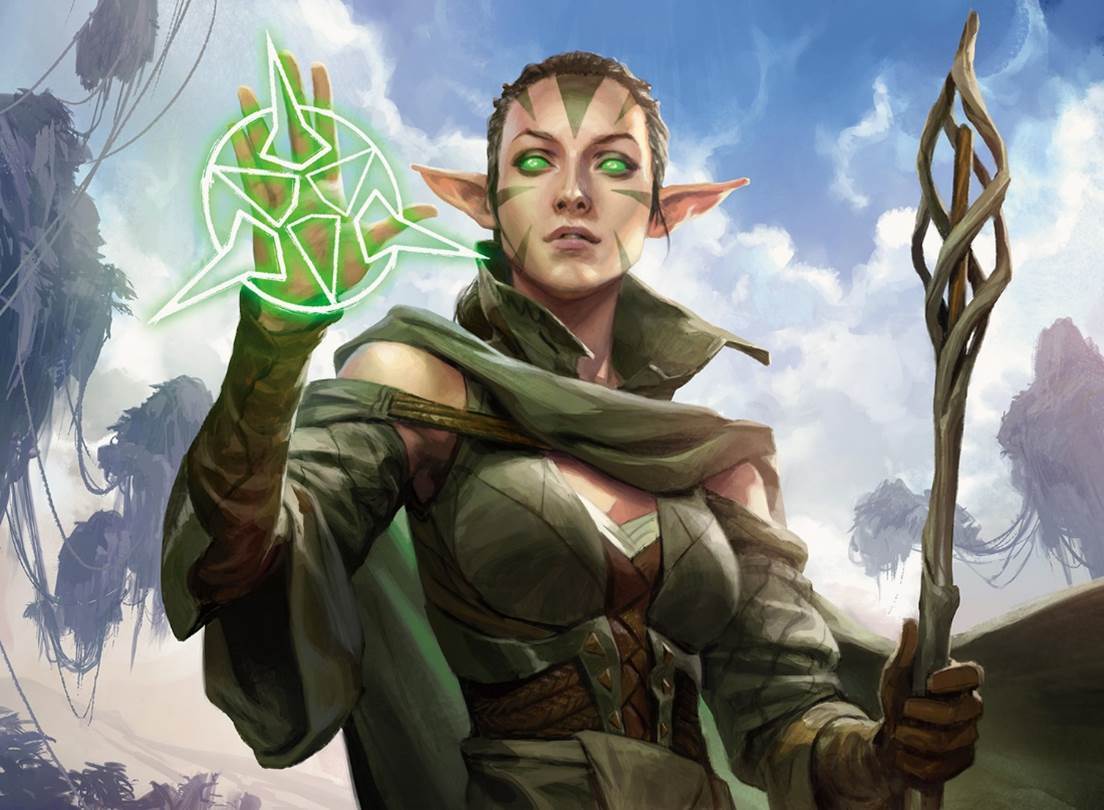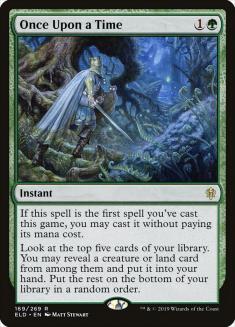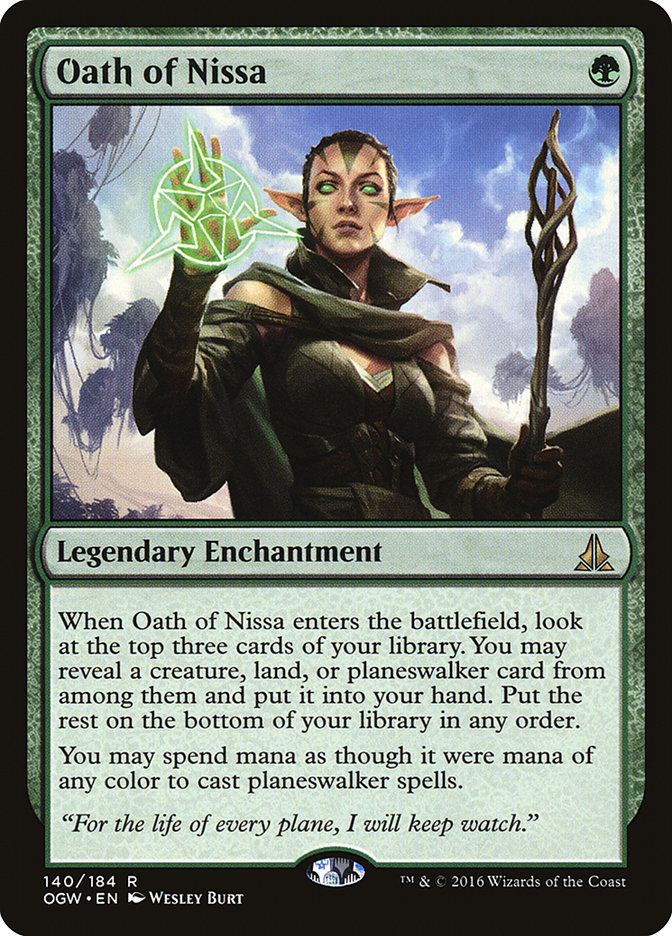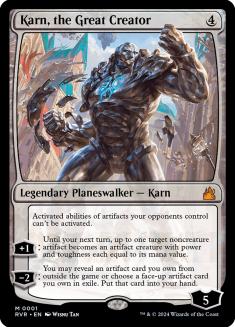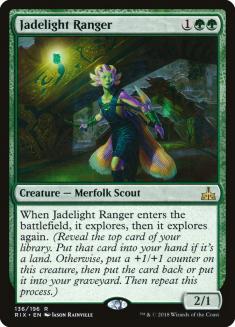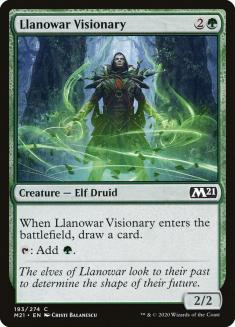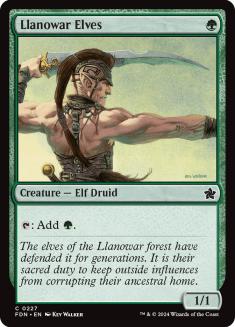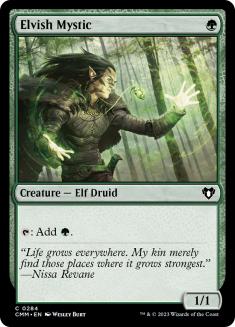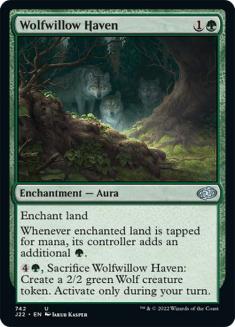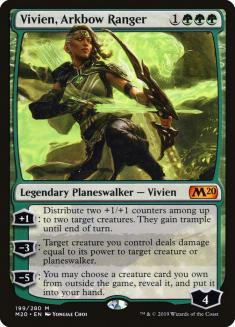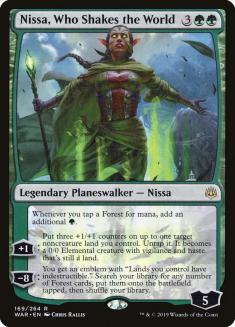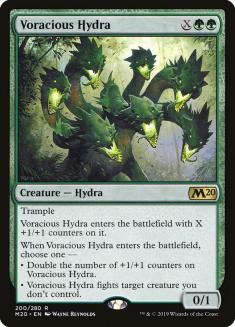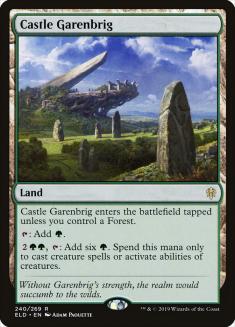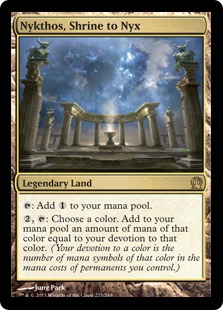Pioneer is back, and with it comes one of the most consistent and powerful archetypes of recent memory. Mono-Green Devotion put up outrageous numbers during an era where full-powered Four-Color Copy Cat was legal. A lot of that was due to the raw power of Mono-Green Devotion and the absurd mana generation of Nykthos, Shrine to Nyx, but the unsung heroes of the archetype were the two cards that made it the most consistent deck I’ve played in twenty years.
Banning Once Upon a Time was one of the smartest plays Wizards of the Coast (WotC) had in their arsenal. Not only did it allow you to find Nykthos, Shrine to Nyx more often, but it made keeping no-land hands a possibility. I kept almost every hand that had Once Upon a Time because it almost always became whatever you were missing. Need an Elf? Go find one. Want a second Burning-Tree Emissary to turbo-power your devotion? Easy game. Need a Forest to go with the near-perfect nuts? Once Upon a Time has you covered.
Once Upon a Time made the deck outrageous because the cards themselves were extremely good. When every card in your deck works well together, tools that increase consistency are invaluable. Once Upon a Time was a once-in-a-decade effect, like Gitaxian Probe or Aether Vial. It might not do all the broken stuff on its own, but it sure allowed for more near-perfect draws than was acceptable. Combined with the London Mulligan, Once Upon a Time almost singlehandedly put Mono-Green Devotion into the “most broken deck I’ve ever played” category. While it’s gone now, the deck remains almost entirely intact otherwise, and the unbanning of Oath of Nissa brings us pretty close to back to where we were.
Alongside Once Upon a Time, Oath of Nissa was a major contributing factor to the success of Mono-Green Devotion. Like Once Upon a Time, it helped find whatever piece you were missing. The only downside is that it actually costs mana, but in return you get a permanent that helps add to your devotion count.
Oath of Nissa was banned because it was a four-of in two different broken strategies and added quite a bit of consistency to both. Many called it the green Ponder, as the level of dig and redundancy it gave you is only matched by Once Upon a Time. Unbanning Oath of Nissa was a statement, and one I’m currently happy with, but I’m not so sure it was the greatest idea in the world. We’ve already seen what it can do in Kethis Combo, as that deck was banned almost immediately after the Oath of Nissa unbanning. Will Oath of Nissa make Mono-Green Devotion into the best deck in Pioneer once again?
A few months ago, during the second age of Pioneer, AspiringSpike created a new version of Mono-Green Devotion in spite of three cards being banned. Without Oath, Once Upon a Time, or Leyline of Abundance, the deck wasn’t as powerful, but one new addition gave it some of the consistency it was missing. The point became to make as much mana as possible, and to use Karn, the Great Creator to use that mana as efficiently as you could.
This bad boy has been a focal point of Modern decks for quite some time, giving many archetypes that generate a ton of mana a toolbox to work with. Nykthos, Shrine to Nyx is only as good as the stuff you can use the mana on, and Karn is a great spell for the mid- or late-game. Like Walking Ballista before it, having a versatile card that gets better the more mana you sink into it is great. Having that spell be good when you don’t have a ton of mana is the tricky part, but I think Karn passes that test easily.
Karn gives a deck like Mono-Green Devotion access to a host of spells (and a land!) for almost any situation. Need a threat? Heart of Kiran. Want some removal? Skysovereign, Consul Flagship has your back. Need to win a super-long game? The Great Henge might be right up your alley. It’s all dependent on how much mana you can generate, but you should be able to find whatever you need for any given situation.
The downside is that playing all those cards means losing most of your sideboard. With Vivien, Arkbow Ranger being another tool for the strategy, having a sideboard full of tutor-able effects is pretty sweet. It also makes sideboarding super-easy. There is nothing more satisfying than screaming “No changes!” at the top of your lungs when someone asks if you should sideboard in a Pithing Needle.
One thing I noticed when playing the original two iterations of Mono-Green Devotion was how little I actually wanted to sideboard. I was able to maindeck Scavenging Ooze, so the majority of my sideboard was stuff like Reclamation Sage. Often, when I was on the play, I chose to not sideboard because my deck was a well-oiled machine. Adding various sideboard cards had very real impacts to my curve, as well as my devotion count. I started leaning toward stuff like Shapers’ Sanctuary because they could at least add towards devotion instead of getting stuck in my hand like Unravel the Aether.
Suffice it to say that I was never in love with my sideboard anyway. The sideboard is where Mr. Ulamog lives. We just asked him if we could store a few of our old toys in his garage, but we’ll be back later to retrieve them.
Jadelight Ranger was an addition to the archetype to help consistency and devotion count after they banned Oath of Nissa. Jadelight Ranger’s higher-than-average power helped it get the nod, because it would often act as card advantage or filtering while leaving a body behind. Other three-drops just weren’t cutting it, and I tried everything! What mattered most was creating a healthy amount of mana generation, but the times where Jadelight Ranger traded with Steel-Leaf Paladin were invaluable.
When Vivien is one of your best threats, any body can be a useful body. It helps if that smaller body can do something in the meantime, and then grow out of control if you put enough counters on it. After all, you only need one or two counters on any creature to turn it into a real threat. Stuff like Burning-Tree Emissary starts to hit pretty hard in conjunction with Llanowar Elves when you spread some counters around.
The newer card, Llanowar Visionary, is a little harder to evaluate because it both taps for mana and generates economy. It’s obviously good, but is it better than Jadelight Ranger for the archetype? I think there’s a chance, but we just haven’t had time to try it just yet. My first League trying out Llanowar Visionary had me loving it, but I’m still not sure if it’s better or worse than the tried-and-true Jadelight Ranger.
In matchups where your opponent kills all your stuff, having that extra card from either Jadelight Ranger or Llanowar Visionary is helpful, but the difference between a random draw and almost always finding a land is a big deal. No chain can start with Jadelight Ranger because you don’t draw anything that isn’t a land, but a late-game Llanowar Visionary can claw you back into a game you have no business winning. I can also appreciate a good one-three-five curve into a super-fast Nissa, Who Shakes the World.
The new iterations of Mono-Green Devotion have already started to produce results. D00mwake, good friend of the stream and Tier 3 Todd Squad member, took down a Pioneer tournament on Magic Online this past weekend. His list was nice and tight, taking elements from the different eras of Pioneer and stringing them together. After going 12-0, defeating Hall of Fame member Gabriel Nassif in the finals, it’s safe to say that the list is pretty good, but that doesn’t mean we can’t improve. Nothing D00mwake played in his list is unique or something we haven’t seen or played with before. It seems like every new set brings ten cards that completely reshape every format, so why can’t Llanowar Visionary be what pushes Mono-Green Devotion back over the top?
Creatures (19)
Planeswalkers (12)
Lands (6)
Spells (23)
Sideboard
- 1 Tormod's Crypt
- 1 Pithing Needle
- 1 Phyrexian Revoker
- 1 Grafdigger's Cage
- 1 Reclamation Sage
- 1 Ulamog, the Ceaseless Hunger
- 1 Aligned Hedron Network
- 1 Skysovereign, Consul Flagship
- 1 Verdurous Gearhulk
- 1 Damping Sphere
- 1 God-Pharaoh's Statue
- 1 Questing Beast
- 1 Stonecoil Serpent
- 1 The Great Henge
- 1 Elder Gargaroth

Let’s talk about the deck and discuss why each card is so important, as well as some common play patterns to keep in mind. If you’ve played a bunch of matches with the archetype, this information should seem obvious, but I’m guessing a lot of you are about to get very interested in Pioneer. As a result, this information can be invaluable.
This deck couldn’t exist without this pair. While functionally the same card, having two different versions allows for some absurd starts, and having eight copies means you’ll almost always have one on the first turn. Once Upon a Time made this much more likely, but the deck can still reliably put Llanowar Elves onto the battlefield on the first turn. Burning-Tree Emissary and Wolfwillow Haven allow for similar starts, but nothing beats the iconic Llanowar Elves opening.
When Once Upon a Time was in the deck, I refused to keep seven-card hands without it or an Elf. My floor for keepable hands is pretty high for this deck, because doing nothing on the first two turns is just unacceptable. With such powerful top-end spells that often turn into more than one card, mulligans in the opening of the game don’t matter as much as they should. With that said, don’t go tossing away solid hands that don’t have Llanowar Elves. A start featuring Burning-Tree Emissary into Wolfwillow Haven is usually good enough. Relying on Oath of Nissa to find an Elf is also okay on occasion depending on the matchup. Remember earlier when I said we weren’t really ramping into three-drops? Llanowar Elves is almost as good on Turn 2 as it is on Turn 1 in our deck.
From the older lists, Wolfwillow Haven stands out to me as a phenomenal addition to the archetype. It breathes new life into Burning-Tree Emissary, a card that generates two mana without a lot to do with it most of the time. The problem is that Burning-Tree Emissary is integral to your nut draws featuring Nykthos, Shrine to Nyx, but lacks meaningful things to do with that mana on a regular basis. The unbanning of Oath of Nissa helps alleviate some of that pressure, but Wolfwillow Haven is the key.
Wolfwillow Haven is a nice mana accelerator that doesn’t die to removal and even adds to the devotion count! If you flood out later, you can pop it to make a Wolf, adding to your pressure and providing you with a valuable body for protecting your planeswalker or soaking up buffs from Vivien.
I know we’ve already discussed Oath of Nissa and the effect it had on the deck in the past, but today’s build utilizes it in a similar way. Not only do we have more virtual copies of our best cards, the additional point of devotion is really nice. It’s a great way to spend extra mana when our first-turn Llanowar Elves doesn’t have much to do, and it can smooth out draws where we need a land. In the later turns, it’s one of the best draws possible because it helps to actually find our best draws. I remember the old adage about Ponder from Legacy: it’s always the best draw because it’s usually your best card and a little sweetness on top.
The second Oath of Nissa is also rarely a dud. Sometimes it costs a little too much for what you need, but the times where you have a ton of extra mana and draw Oath of Nissa are happy turns. Those are the turns where you find Karn and then cast The Great Henge. Oath of Nissa allows for all that and more because it provides you with consistency that green decks don’t normally have. It’s such a heater at nearly every stage of the game, because even when you’re behind on mana, it provides you with an opportunity to be free if you hit a land off it. Being good at most stages of the game is a huge deal, and one of the reasons I like this archetype so much. Nearly every card puts an emphasis on generating mana, but multiple cards have the ability to completely change functionality when you meet a certain threshold.
It didn’t take me long to understand just how messed up Vivien could be. It started as an interactive way to apply pressure and provide you with another threat that doesn’t die to Supreme Verdict. What we ended up with was an incredibly efficient way to generate an Ulamog, the Ceaseless Hunger on the fourth turn. Vivien isn’t as versatile as Karn as far as what it can tutor for, but it is exceptional if left unchecked.
There are times where it is 100% correct to minus and kill a creature, but there are more times still where making sure your Vivien has the potential to “ultimate” is much more important. If you have Nykthos, Shrine to Nyx at the ready, Vivien, Arkbow Ranger helps generate so much devotion. It is surprisingly easy to generate ten mana with access to both of those cards.
Depending on the matchup, you want to make sure some creatures reach a certain toughness threshold with her pump ability. Having one creature survive Anger of the Gods is huge, as that creature can continue to gain more counters and attack on the following turn. Sometimes it’s just important to manage power and toughness for the sake of future combat steps. Yes, the combat step actually matters in Pioneer! Pretty incredible, right?
Nissa is a different animal entirely, but it’s still part of almost every nut draw. It doesn’t go nearly as hard without Walking Ballista in the deck, but you can certainly find a number of interesting uses for the extra mana that Nissa generates. The best part of Nissa is the mana generation, but that is followed closely by her ability to create pressure on opponents that aren’t established on the battlefield. Making a 3/3 with haste every turn is pretty bonkers, but that’s only exacerbated by the overwhelming mana generation.
I don’t need to tell y’all how good Nissa is. Most of you have played against it or with it a ton over the last year and change. It’s one of those busted planeswalkers out of War of the Spark, and we know just how good most of those are across every format. Nissa specifically gives this deck an aggressive slant while providing you with a personal Mana Flare. It’s incredible. It’s also one of those cards that’s absurdly hard to beat if your opponent ever untaps with one. The second activation and first full turn of double mana is nutty.
At some point, I figured out that we needed most of our payoffs for Mono-Green Devotion to be versatile in casting cost but also somewhat interactive. Walking Ballista and Voracious Hydra did both of those well, acting as cheap removal for opposing Llanowar Elves while giving you some incredible stats as the game progressed. Voracious Hydra is one of the biggest creatures you can ask for on rate when you double it up, it has trample, and it will kill just about everything your opponent throws at you if things are firing on all cylinders.
Voracious Hydra is one of those cards that you weren’t sure would be good, yet ultimately becomes one of the most important parts of a deck. It started as a sideboard card, but I would regularly bring it in for interaction over Hydroid Krasis because fighting an opposing threat was too important. In the beginning of Pioneer, having interaction points from a linear deck was a huge deal. Walking Ballista was good against Felidar Guardian because it could check Saheeli Rai mid-combo. Voracious Hydra was important because it could tag Thing in the Ice before it bounced your battlefield and killed you. Nowadays, everything keeps getting banned, so we’re left just playing the last best option.
Voracious Hydra doesn’t always need to kill something. If you aren’t in much danger and your opponent’s deck is light on removal, you’d be surprised how many games you can just steal by making a huge monster with trample. I try to kill stuff when it matters, but I also gamble a little bit when it’s obvious my opponent doesn’t have creature removal at the ready.
I’ve tried to get Nykthos, Shrine to Nyx banned in Pioneer for about a year now. The card is outrageous, and is the source of almost every nut draw. The amount of mana it generates when you’re ahead is brutal, and it eclipses just about anything else you can do in the format in terms of power level. While this version is a little bit worse than previous iterations, things are just fine. Karn is a great mana sink for Nykthos, even if we don’t have Walking Ballista anymore.
Castle Garenbrig will occasionally mess up your draw, but it’s not often enough or relevant enough to cut, and I’ve had the extra mana boost be exactly the right amount for Voracious Hydra more times than I can count.
Forest is obviously the bread and butter of the archetype, but I wanted to stress just how good it is to play a monocolor manabase. The mana in Pioneer is challenging because they’ve banned fetchlands. That means allied mana is horrible, and three-color mana is often as good as or better than two-color mana depending on the combination. It’s funny but I’d argue that Five-Color Niv-Mizzet has one of the best manabases in the format. I never see them unable to cast their spells!
The Sideboard, or Lack Thereof
Never sideboard anything in. Ever. Just use your tutor effects to have a toolbox instead of stressing about how many copies of Aether Gust to bring in.
The cards in our sideboard are there because they are part of a broad package to cover as many bases as we can in fifteen sideboard slots. Is this the perfect fifteen? Probably not. Those choices will also change from day to day based on the expected metagame. There are so many artifacts to choose from and so many scenarios where they can be good or great. The trick, as always, will be staying on top of shifting metagames and choosing the best package at your disposal.
This Mono-Green Devotion deck has gone through so many changes and bans over the last year that it’s hard to know which version was the best before it got nerfed. I’m not even sure Leyline of Abundance was ever a problem, but I digress.
If you’re just looking to get into Pioneer, just check out my stream. I’m on playing Pioneer almost every single day around 3pm ET. I’ll be playing this deck a lot over the next few days as I prepare for this weekend’s events. See you there!

